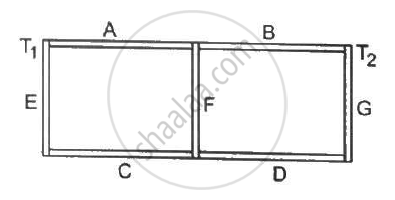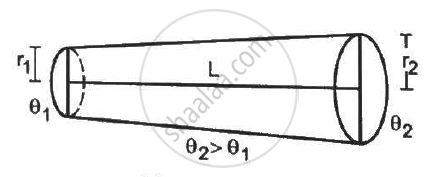Advertisements
Advertisements
Question
Two bodies of masses m1 and m2 and specific heat capacities s1 and s2 are connected by a rod of length l, cross-sectional area A, thermal conductivity K and negligible heat capacity. The whole system is thermally insulated. At time t = 0, the temperature of the first body is T1 and the temperature of the second body is T2 (T2 > T1). Find the temperature difference between the two bodies at time t.
Solution
Rate of transfer of heat from the rod is given by
`(DeltaQ)/(Deltat) = (KA(T_2 - T_1))/l`
Heat transfer from the rod in time ΔΔ t is given by
`(DeltaQ)/(Deltat) = (KA(T_2 - T_1))/l Deltat ............(1)`
Heat loss by the body at temperature T2 is equal to the heat gain by the body at temperature T1
Therefore, heat loss by the body at temperature t2 in time Δt is given by
`DeltaQ = m_2s_2(T_2 - T_2) ....(2)`
from equation (i) and (ii)
`m_2s_2(T_2 - T_2')= (KA(T_2 - T_1))/l Delta t`
`⇒ T_2' = T_2 - (KA(T_2 - T_1))/(l(m_2s_2)) Delta t`
This gives us the fall in the temperature of the body at temperature T2.
Similarly, rise in temperature of water at temperature T1 is given by
`T_1' = T_1 + (KA(T_2 - T_1))/(l(m_1s_1)) Delta t`
Change in the temperature is given by
`(T_2' - T_1') = (T_2 - T_1) - [(KA (T_2 - T_1))/(lm_1s_1) Deltat + (KA(T_2 - T_1))/(lm_2s_1)Delta t]`
`⇒(T_2' - T_1') - (T_2 - T_1) = - [(KA(T_2 - T
_1))/(lm_1s_1) Deltat + [(KA(T_2 - T
_1))/(lm_2s_2) Deltat]`
`rArr (DeltaT)/(Deltat)= (KA(T_2 - T_1))/l [1/(m_1s_1) + 1/(m_2 s_2)] Deltat`
`rArr 1/(T_2 - T_1) DeltaT =- (KA)/l [(m_1s_1 + m_2s_2)/(m_1s_1m_2s_2)] `
On integrating both the sides, we get
lim Δ t → 0
`int 1/(T_2 - T_1)dT = int - (KA)/l [( m_1s_1 + m_2s_2)/(m_1s_1m_2s_2) ]dt`
⇒ `In [T_2 - T_1] = - (KA)/l [( m_1s_1 + m_2s_2)/(m_1s_1m_2s_2)]t`
⇒ `(T_2 - T_1) = e^(-lamda t)`
Here , `lamda = "KA/l [ "m_1s_1 + m_2s_2"/"m_1s_1m_2s_2"]`
APPEARS IN
RELATED QUESTIONS
A bullet of mass 20 g enters into a fixed wooden block with a speed of 40 m s−1 and stops in it. Find the change in internal energy during the process.
A block of mass 100 g slides on a rough horizontal surface. If the speed of the block decreases from 10 m s−1 to 5 m s−1, find the thermal energy developed in the process.
The blocks of masses 10 kg and 20 kg moving at speeds of 10 m s−1 and 20 m s−1respectively in opposite directions, approach each other and collide. If the collision is completely inelastic, find the thermal energy developed in the process.
The thermal conductivity of a rod depends on
A pitcher with 1-mm thick porous walls contains 10 kg of water. Water comes to its outer surface and evaporates at the rate of 0.1 g s−1. The surface area of the pitcher (one side) = 200 cm2. The room temperature = 42°C, latent heat of vaporization = 2.27 × 106 J kg−1, and the thermal conductivity of the porous walls = 0.80 J s−1 m−1°C−1. Calculate the temperature of water in the pitcher when it attains a constant value.
Water at 50°C is filled in a closed cylindrical vessel of height 10 cm and cross sectional area 10 cm2. The walls of the vessel are adiabatic but the flat parts are made of 1-mm thick aluminium (K = 200 J s−1 m−1°C−1). Assume that the outside temperature is 20°C. The density of water is 100 kg m−3, and the specific heat capacity of water = 4200 J k−1g °C−1. Estimate the time taken for the temperature of fall by 1.0 °C. Make any simplifying assumptions you need but specify them.
The ends of a metre stick are maintained at 100°C and 0°C. One end of a rod is maintained at 25°C. Where should its other end be touched on the metre stick so that there is no heat current in the rod in steady state?
A hole of radius r1 is made centrally in a uniform circular disc of thickness d and radius r2. The inner surface (a cylinder a length d and radius r1) is maintained at a temperature θ1 and the outer surface (a cylinder of length d and radius r2) is maintained at a temperature θ2 (θ1 > θ2). The thermal conductivity of the material of the disc is K. Calculate the heat flowing per unit time through the disc.
A hollow tube has a length l, inner radius R1 and outer radius R2. The material has a thermal conductivity K. Find the heat flowing through the walls of the tube if (a) the flat ends are maintained at temperature T1 and T2 (T2 > T1) (b) the inside of the tube is maintained at temperature T1 and the outside is maintained at T2.
An aluminium rod and a copper rod of equal length 1.0 m and cross-sectional area 1 cm2 are welded together as shown in the figure . One end is kept at a temperature of 20°C and the other at 60°C. Calculate the amount of heat taken out per second from the hot end. Thermal conductivity of aluminium = 200 W m−1°C−1 and of copper = 390 W m−1°C−1.

Following Figure shows an aluminium rod joined to a copper rod. Each of the rods has a length of 20 cm and area of cross section 0.20 cm2. The junction is maintained at a constant temperature 40°C and the two ends are maintained at 80°C. Calculate the amount of heat taken out from the cold junction in one minute after the steady state is reached. The conductivites are KAt = 200 W m−1°C−1 and KCu = 400 W m−1°C−1.

Suppose the bent part of the frame of the previous problem has a thermal conductivity of 780 J s−1 m−1 °C−1 whereas it is 390 J s−1 m−1°C−1 for the straight part. Calculate the ratio of the rate of heat flow through the bent part to the rate of heat flow through the straight part.
Seven rods A, B, C, D, E, F and G are joined as shown in the figure. All the rods have equal cross-sectional area A and length l. The thermal conductivities of the rods are KA = KC = K0, KB = KD = 2K0, KE = 3K0, KF = 4K0 and KG = 5K0. The rod E is kept at a constant temperature T1 and the rod G is kept at a constant temperature T2 (T2 > T1). (a) Show that the rod F has a uniform temperature T = (T1 + 2T2)/3. (b) Find the rate of heat flowing from the source which maintains the temperature T2.

Find the rate of heat flow through a cross section of the rod shown in figure (28-E10) (θ2 > θ1). Thermal conductivity of the material of the rod is K.

A hollow metallic sphere of radius 20 cm surrounds a concentric metallic sphere of radius 5 cm. The space between the two spheres is filled with a nonmetallic material. The inner and outer spheres are maintained at 50°C and 10°C respectively and it is found that 100 J of heat passes from the inner sphere to the outer sphere per second. Find the thermal conductivity of the material between the spheres.
An amount n (in moles) of a monatomic gas at an initial temperature T0 is enclosed in a cylindrical vessel fitted with a light piston. The surrounding air has a temperature Ts (> T0) and the atmospheric pressure is Pα. Heat may be conducted between the surrounding and the gas through the bottom of the cylinder. The bottom has a surface area A, thickness x and thermal conductivity K. Assuming all changes to be slow, find the distance moved by the piston in time t.
A spherical ball of surface area 20 cm2 absorbs any radiation that falls on it. It is suspended in a closed box maintained at 57°C. (a) Find the amount of radiation falling on the ball per second. (b) Find the net rate of heat flow to or from the ball at an instant when its temperature is 200°C. Stefan constant = 6.0 × 10−8 W m−2 K−4.
